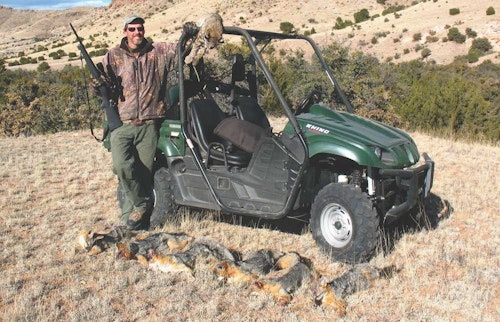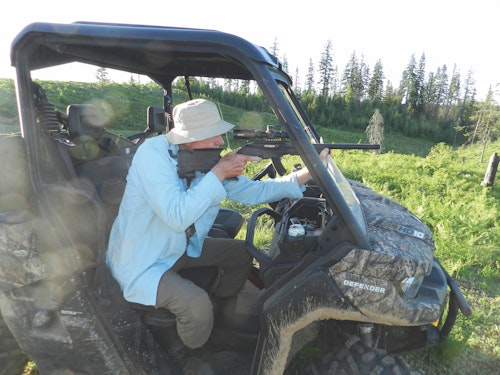I’m old enough to remember a raw fur market robust enough to support the spartan existence of an ambitious lad fresh out of high school, and a complete absence of ATVs. I spent the first several months after release from formal education working for an outfitter, guiding clients to big-game success. But with fall big-game seasons concluded, and reports of $65 coyotes, $55 gray foxes and $400 bobcats, collecting fur for the high-fashion markets of New York and Europe seemed a viable career move. With guiding funds, I purchased a used ’68 Toyota Land Cruiser. Still, in my estimation, the best full-size off-road vehicle ever conceived, traversing backroads covered with treacherous snow and mud, tire-busting rocks and erosion cuts big enough to swallow Cape buffalos. But fuel to that Cruiser was like booze to sailors on leave, fed daily from 55-gallon drums representing precious capital. It also developed flat tires more often than I changed my underwear. I spent my days predator calling and checking traps and prying my heavy vehicle from various troubles. How I would have loved to own an ATV or UTV! But alas, the ATV waited many years in the future.
I’ve revisited this carefree lifestyle during more recent fur-market spikes, if only as a side job. Fur is still worth something today — enough so that predator calling is still that rare outdoor pastime that can actually pay for itself — but has taken on a more recreational tone than those desperate days of the early ’80s, or more recent calling binges when fur funded the acquisition of expensive toys. For the past 20 or so years, a pickup truck has served only as a vehicle to ferry an ATV (sit on top) or UTV (side-by-side) closer to the action, left behind while piloting a “four-wheeler.”

Smaller Can Be Better
There are many advantages to smaller all-terrain vehicles while predator calling, whether serious business or pure recreation. Largest among these is more efficient fuel consumption. Instead of burning 10 gallons of fuel daily, I might burn 2 gallons — considerable savings multiplied by many days on end. This is a big deal if you’re in this for a profit, but just as germane while pursuing predators for sport. That savings also translates into much less wear and tear on full-size vehicles and their expensive tires. Too, on ranch and back roads that would leave you idling along in a truck or SUV to avoid breaking something vital, an ATV or UTV glides along at 25 or 30 mph. This means you’re able to cover more ground on any given outing, a difference that might mean making five to seven additional calling setups per diem, every one of those a potential coyote, fox or bobcat pelt to put on a stretcher.
As they pertain to predator calling, ATVs and even larger side-by-sides are a tad easier to stash out of sight while calling than a full-size vehicle. Stab an ATV into a healthy clump of sage, pull a swatch of camouflage netting over it and it ceases to exist. Park a UTV between a pair of ground-hugging cedars and it disappears. A stock-pond dike, steep-walled sand wash, small outcrop or hill lip hides a smaller all-terrain vehicle convincingly in places where a truck or SUV would remain as conspicuous as a beach ball on a putting green. Convincingly making your ride disappear in the landscape means more wary predators responding to your calling efforts.
The ATV-UTV/camouflage-cover concept really comes into its own for predator hunters unable to walk great distances, whether due to advanced age or handicap. Rancho Safari’s Field Blankets (designed for waterfowl field hunting) especially shine here, hundreds of hanks of burlap, hemp rope and camouflage-material strips hand sewed to industrial-grade camo netting. With such convincing cloaking — and carefully playing wind — you could conceivably park an ATV in the wide-open, cover it in its “ghillie” blind and use your ATV itself as calling cover. We have definitely done just this during nighttime calling sessions for Southwest gray foxes on private lands, covering an ATV to eliminate moonbeam glint, using the unit as a power base for a spotlight.

Tread Lightly
Light ATVs and side-by-sides also reap less havoc on winter-softened roads. There are simply trails and ranch roads, that while perfectly passable with full-size vehicles during dryer months, turn to mire with a couple months of wet winter weather. There was a reason I spent so much time stuck during those early days — include a couple feet of snow, a few freezes and thaws, add a persistent day of sunshine and the bottom often fell out of those Forest Service two-rutters we’d enjoyed during deer or elk seasons. A 4WD truck or SUV down on its axles in bottomless mud is a sad sight indeed and means your day just turned sour. Lighter all-terrain vehicles float over such uncertain footing. On public lands, deeply rutting roads can lead to fines. On private land, tiring up a ranch/farm roadway does not ingratiate you to landowners and will likely lead to lost trespass rights.
Despite Americans’ bigger-is-better mentality, I’ve found that smaller ATVs are often superior in the most treacherous terrains, especially when mud and snow enter the equation. The reason is simple enough: Lighter ATVs can be manhandled should they, say, need to be dislodged from a mud hole or snowbank, or slide into an erosion cut or high center on a boulder. They are also nimbler — experienced riders able to throw their weight around for added control in questionable or tilted terrain. They are also easier to drive straight into a pickup bed for transport. After a couple broken rear glasses, one lesson I learned is constructing a 2x10-inch lumber stop to prevent this common disaster. My base-model 500cc unit, for instance, also includes a pull starter, which came in handy when rough terrain dislodged cables and left my battery dead. No matter the type of all-terrain vehicle, I always carry a simple tire-plug kit and foot pump for unexpected flats far from civilization. The biggest ATVs have more power, indeed, but how much horsepower do you really need — keeping up with the Jones’ set well aside? Larger units also consume more fuel per mile ridden. Still, larger ATV units are generally more comfortable to ride (some including power-assist steering) and more comfortably accommodate cargo such as rifle boots, coolers and the like.

The UTV Advantage
That said, larger side-by-side units provide many obvious advantages. That second seat allows a welcomed hunting companion to ride much more comfortably — and safely — for one. The roll-bar cage allows adding windscreens and covers, offering much more protection during chilly or wet weather. During spring small-varmint campaigns, roll bars also offer steadying rests while sniping ground squirrels or prairie dogs. The roll bar also makes an ideal platform for quick-deploy racks that keep rifles handy should an unexpected opportunity present itself between calling setups. A UTV’s cargo box provides an obvious advantage.
While ATVs can certainly tote coolers, rifles, spare togs and the like, this does require tediously applying bungee cords and ratchet straps. The side-by-side cargo box makes it easy to toss such gear aboard for all-day forays. Side-by-sides can certainly be driven into pickup beds — I did so daily while doing coyote control work for various ranchers in New Mexico — but they are heavy and don’t ride especially well. This means trailering, something I’m generally averse to, because it’s one more thing to maintain/license and they introduce difficulties in tight parking spots or dead-end roads. Something I’ve relatively limited experience with (via guided whitetail hunts) but see huge potential for predator calling, for obvious reasons, are electric-powered units. These silent, exhaust-free units would be especially welcomed in Eastern settings where calling ground is more limited and the risk of burning properties is real. All models I have seen are UTV designs allowing easy transport of all the necessary gear. Other than some crunching gravel or snapping sticks beneath the tires, they are truly silent, an obvious stealth advantage. Electric units are gaining range capabilities every year.
Still, other than on smaller private ranches, I would be a bit reluctant to venture out into the vast spaces of the mountain West with an electric vehicle, though the imagination reels at the thought of such silent stealth when approaching calling sites. I would think they would cut down on how far you would have to walk away from vehicles between setups and help fool the most neurotic, hunter-wise coyotes. No doubt, there are dogs out there that equate the sound of an internal-combustion engine with danger.






